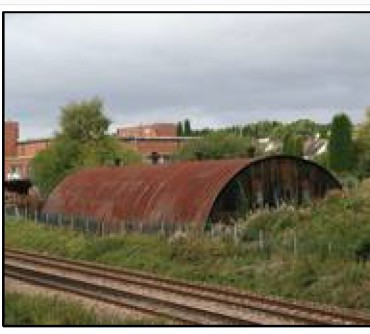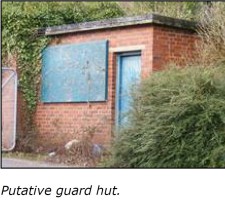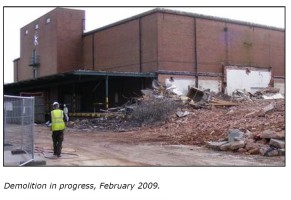
A Brief Introduction to
Twentieth-Century Military and Civil Defence
Archaeology in Devon
Cold Store - Pinhoe - Exeter
Nissen/Romney-type hut
adjacent to the main railway line
During the Second World War the government of the day organised depots for the strategic stockpiling of foods – cold stores, grain stores, fuels stores and general warehouses – and most structures were adjacent to a main road and/or a railway siding. Purpose-built stores were constructed to a standard design, examples of which have been noted at: a cold store at Goldsborough in North Yorkshire, which is reported to be of Second World War origin; a cold store at Farncombe in Surrey; and a wartime store at Sutton-in-Ashfield in Nottinghamshire.
Emergency measures for food distribution and control were put in place during hostilities and these included a zonal stock distribution scheme that, in the event of an area being cut off from the supply network or when communications were too difficult to maintain stocks, allowed wholesalers and retailers to be replenished by drawing on Ministry stocks stored in the zone.
The country was divided into
104 zones (nine in the southwest) in which the Ministry of Food kept essential foods. In 2007 a commercial cold store in Chancel Lane, Pinhoe – a
suburb of Exeter – was earmarked for demolition.
The site (National Grid Reference: SX 95929420) was destined for re-development for
housing and demolition took place in early 2009. The store was identical in design to those mentioned above, was adjacent to a main road and to a main railway line, from which a siding once looped to the facility. From this evidence it could be concluded that the building had a wartime connection, although firm information from local sources has proved to be elusive.
The date of 1942 and mention of the involvement of a government body tends to confirm the speculation about the store’s origins. The presence of what was possibly a guard hut at the site entrance(seen also at Sutton-in-Ashfield), illustrated above, and a Nissen/Romney-type hut adjacent to the main building, similar to those used by the military and government departments, supports the theory.
Sources:
Cocroft, W.D. and Thomas, R.J.C. 2003. Cold War: Building for Nuclear
Confrontation 1946-1989. English Heritage, Swindon.
Devon Record Office: Exeter City Archives, Town Clerk’s Papers.
Express and Echo, 10 February 2009.
Site visits.
www.exeter.gov.uk.
Copyright ©2010 Mike Passmore
50 Southbrook Road, Exeter EX2 6JE
This leaflet (no. 10) is one of a series offering a brief introduction to twentieth century
military and civil defence archaeological features and structures in Devon.
While most can still be seen, some were being removed as this research was
undertaken in 2009/10, and some are earmarked for future demolition.
The source list on page four provides a guide to further study.



